Physics I Module of the MCAT Self Prep eCourse: Lesson 7: Bernoulli's Equation (Pro)
1/38
There's no tags or description
Looks like no tags are added yet.
Name | Mastery | Learn | Test | Matching | Spaced |
|---|
No study sessions yet.
39 Terms
Lesson 7: Bernoulli's Equation
Lesson 7: Bernoulli's Equation
CRB The most simple of the flow rate equations relies upon the cross-sectional area of the pipe and one other factor. Write out this fundamental Flow Rate equation.
f = Av
f = flow rate
A = Cross-sectional area
v = velocity of the fluid
Struggling to keep your MCAT equations straight? Simply conquer the 100 most important equations using Andrew's 100 Most Essential Equations Mastery Course @ https://mcatselfprep.com/course/andrews-equation-mastery-course/
CRB If I have a fluid that is flowing at a rate of 44 m^3/s and the velocity of the fluid is 10.5 m/s, what is the cross-sectional area of the pipe?
(A) 0.24 m^2
(B) 2.08 m
(C) 4.19 m^2
(D) 462 m^2
(C) 4.19 m^2
f = 44 m^3/s
v = 10.5 m/s
f = Av
A = f/v
A = 44/10.5 = 4.19 m^2 (approx 4 m^2)
Need help with MCAT math? Become an MCAT math wizard using Andrew's High-speed Math Mastery Course @ https://mcatselfprep.com/course/andrews-high-speed-math-mastery-course/
CRB The Continuity Equation is a logical continuation of this flow rate equation to compare a section of pipe where each end has a different cross-sectional area. Write out the Continuity Equation.
A1v1 = A2v2
A1 = Cross sectional area of end 1
v1 = Velocity of fluid at end 1
A2 = Cross sectional area of end 2
v2 = Velocity of fluid at end 2
Struggling to keep your MCAT equations straight? Simply conquer the 100 most important equations using Andrew's 100 Most Essential Equations Mastery Course @ https://mcatselfprep.com/course/andrews-equation-mastery-course/
CRB The circulatory system has a system of "pipes" that vary in width. Imagine a single artery narrows right before branching off. If the beginning of the artery has a fluid velocity of 2.58 m/s and an area of 12 cm^2, what is the velocity of blood at the narrowing where the area is only 4.8 cm^2?
(A) 0.645 m/s
(B) 6.45 m/s
(C) 64.5 m/s
(D) 645 m/s
(B) 6.45 m/s
Note: You should convert from cm^2 to m^2! Because the units are squared, 1 m^2 is equal to 10,000 cm^2, not 100.
A1v1 = A2v2
(0.0012)(2.58) = (0.00048) v2
v2 = (0.00310) / (0.00048)
v2 = 6.45 m/s (approx 6 m/s)
Need help with MCAT math? Become an MCAT math wizard using Andrew's High-speed Math Mastery Course @ https://mcatselfprep.com/course/andrews-high-speed-math-mastery-course/
CRB If A1 = 4(A2), then how would v1 compare to v2?
(A) v1 = 4(v2)
(B) v1 = v2
(C) 4(v1) = v2
(D) 16(v1) = v2
(C) 4(v1) = v2
If the area of section 1 is 4 times greater than at section 2, then the velocity at section 2 must be 4 times greater than the velocity at section 1.
CRB True or false? Because the Circulatory System as a whole is a closed loop, it must have a Constant Flow Rate due to the Continuity Equation.
False. Although the Circulatory System as a whole is a closed loop, its valves, gravity, and the elasticity of our blood vessels make the flow rate inconsistent.
What is Bernoulli's equation in terms of pressure, height, and velocity of a fluid at two points in a pipe?
P1 + 1/2ρv1^2 + ρgh1 = P2 + 1/2ρv2^2 + ρgh2
P1 = Pressure at Point 1 (Pa)
P2 = Pressure at Point 2 (Pa)
ρ = Density of the Fluid (kg/m^3)
v1 = Velocity at Point 1 (m/s)
v2 = Velocity at Point 2 (m/s)
g = Acceleration due to Gravity (9.8m/s^2)
h1 = Height at Point 1 (m)
h2 = Height at Point 2 (m)
Another way to look at this is as Wi + PEi + KEi = Wo + PEo + KEo, where i is for input and o is for output
Struggling to keep your MCAT equations straight? Simply conquer the 100 most important equations using Andrew's 100 Most Essential Equations Mastery Course @ https://mcatselfprep.com/course/andrews-equation-mastery-course/
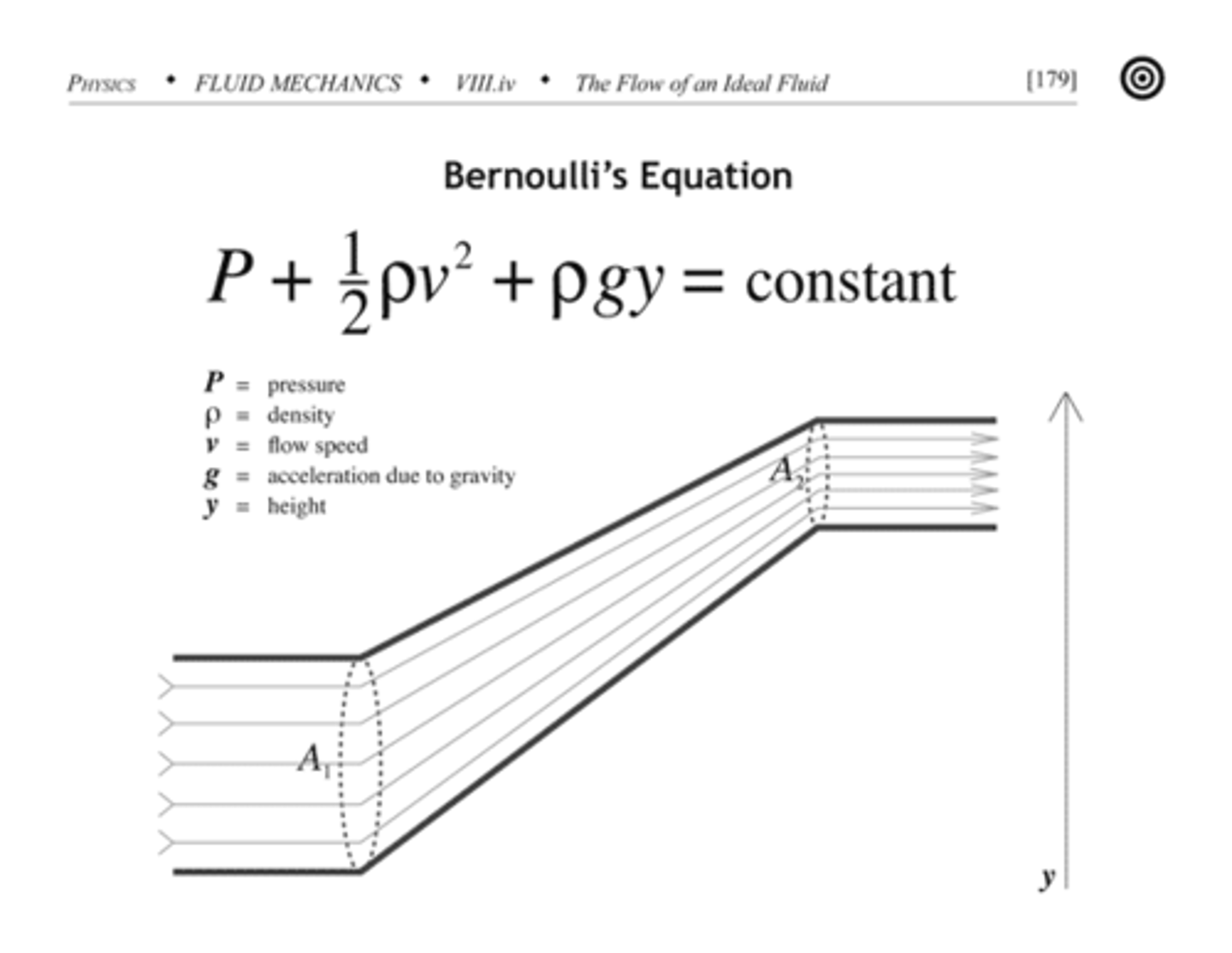
CRB Fill in the blanks: In Bernoulli's Equation, the terms can be grouped into two different types of pressures. P + ρgh can be referred to as ___________ and 1/2ρv^2 can be referred to as ____________.
(A) Static Pressure, Dynamic Pressure
(B) Dynamic pressure, Static Pressure
(C) Dynamic Pressure, Environmental Pressure
(D) Environmental Pressure, Dynamic pressure
(A) Static Pressure, Dynamic Pressure
In Bernoulli's Equation, the terms can be grouped into two different types of pressures. P + ρgh can be referred to as Static Pressure and 1/2ρv^2 can be referred to as Dynamic Pressure.
CRB For Bernoulli's Equation to hold true, the fluid must be assumed to be an Ideal Fluid. Which of the following is NOT one of the four conditions of an ideal fluid?
(A) The flow is Turbulent
(B) The fluid is Incompressible
(C) The fluid has negligible viscosity
(D) The flow rate is steady
(A) The flow is Turbulent
Below are the 4 conditions of an Ideal Fluid:
I. The flow is Laminar
II. The fluid is Incompressible
III. The fluid has negligible viscosity (Inviscid fluid)
IV. The flow rate is steady
Water is flowing through a pipe of varying cross sectional area down a hill with a velocity of 10 m/s at the top and 20 m/s at the bottom. Over this distance, the pipe goes from a height of 10 m to a height of 0 m. The water is at a pressure of 1,000,000 Pascals at the top. What is the pressure at the bottom (use 10 m/s^2 for g for simplicity)?
(A) 820,000
(B) 950,000
(C) 1,240,000
(D) 1,560,000
(B) 950,000
P1 + 1/2ρv1^2 + ρgh1 = P2 + 1/2ρv2^2 + ρgh2
(1000000) + (.5)(1000)(10^2) + (1000)(10)(10) = P2 + (.5)(1000)(20^2) + (1000)(10)(0)
1150000= P2 + 200000
P2 = 950,000 Pa
Need help with MCAT math? Become an MCAT math wizard using Andrew's High-speed Math Mastery Course @ https://mcatselfprep.com/course/andrews-high-speed-math-mastery-course/
CRB Based on Bernoulli's Principle, Pressure can be related to velocity. Which of the following is the proper explanation of the Bernoulli (or Venturi) Effect?
(A) As flow speed increases, pressure increases.
(B) As flow speed decreases, pressure decreases.
(C) Pressure is greater where there is more gravitational potential energy.
(D) Pressure is greater where the flow speed is lower.
(D) Pressure is greater where the flow speed is lower.
What is the equation for Force of Viscosity in terms of depth and velocity?
F = η ((A v)/d)
F = Force of Viscosity on an object
η =Coefficient of Viscosity
A = Area in contact with fluid
v = velocity of object
d = depth of fluid
The units of viscosity are Pa*s
Struggling to keep your MCAT equations straight? Simply conquer the 100 most important equations using Andrew's 100 Most Essential Equations Mastery Course @ https://mcatselfprep.com/course/andrews-equation-mastery-course/
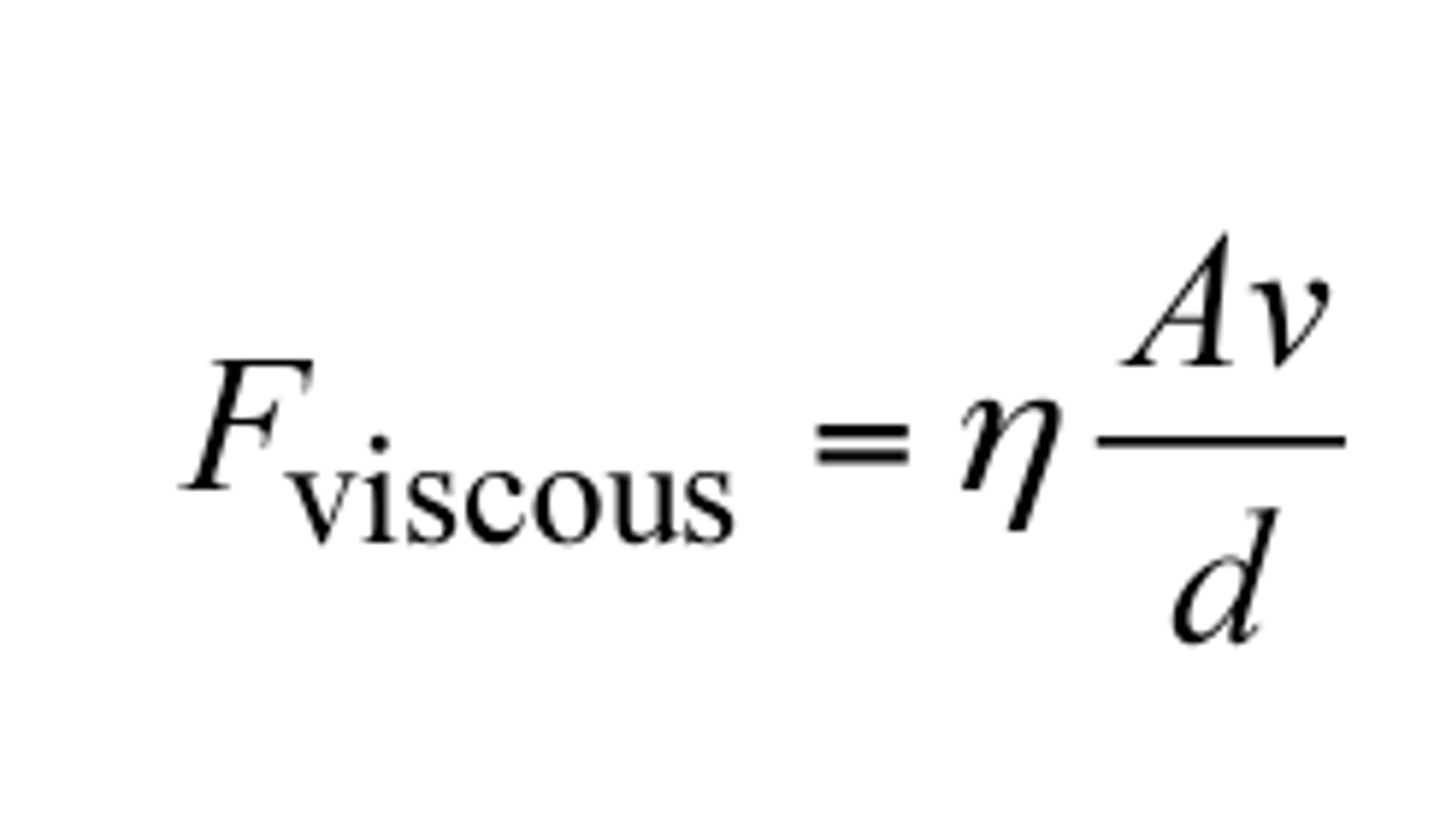
CRB True or false? Viscous drag is a non-conservative force and analogous to air resistance.
True. Viscous drag is a non-conservative force and analogous to air resistance.
Water is flowing through a level pipe. One end of the pipe has an area of 4 m^2, while the other end has an area of 1/4 m^2. The pressure at the entrance is 200,000 Pa, while the pressure at the exit is 100,000 Pa. What is the Flow Rate in the pipe (m^3/s)?
(A) 3.54
(B) 53.33
(C) 0.8769
(D) 112.47
(A) 3.54
v1A1 = v2A2 = Flow Rate = R
v1 = R/4
v2 = R/(.25) = 4R
P1 + 1/2ρv1^2 + ρgh1 = P2 + 1/2ρv2^2 + ρgh2
(200,000) + (.5)(1000)(R/4)^2 + (1000)(9.8)(h) = (100,000) + (.5)(1000)(4R)^2 +(1000)(9.8)(h)
Subtract (1000)(9.8)(h) from each side
(200,000) + (.5)(1000)(R/4)^2 = (100,000) + (.5)(1000)(4R)^2
100,000 + ( 500)(R/4)^2 = 500 (4R)^2
100,000 = 500 ((4R)^2-(R/4)^2)
simplify by actually squaring the flow rates and dividing by 500 on both sides
200=16R^2 - R^2/16
200=(255/16)R^2
12.54=R^2 (Approximately 10)
3.54=R (Approximately 3)
R = approx. 3 m^3/s (3.54 m^3/s)
Need help with MCAT math? Become an MCAT math wizard using Andrew's High-speed Math Mastery Course @ https://mcatselfprep.com/course/andrews-high-speed-math-mastery-course/
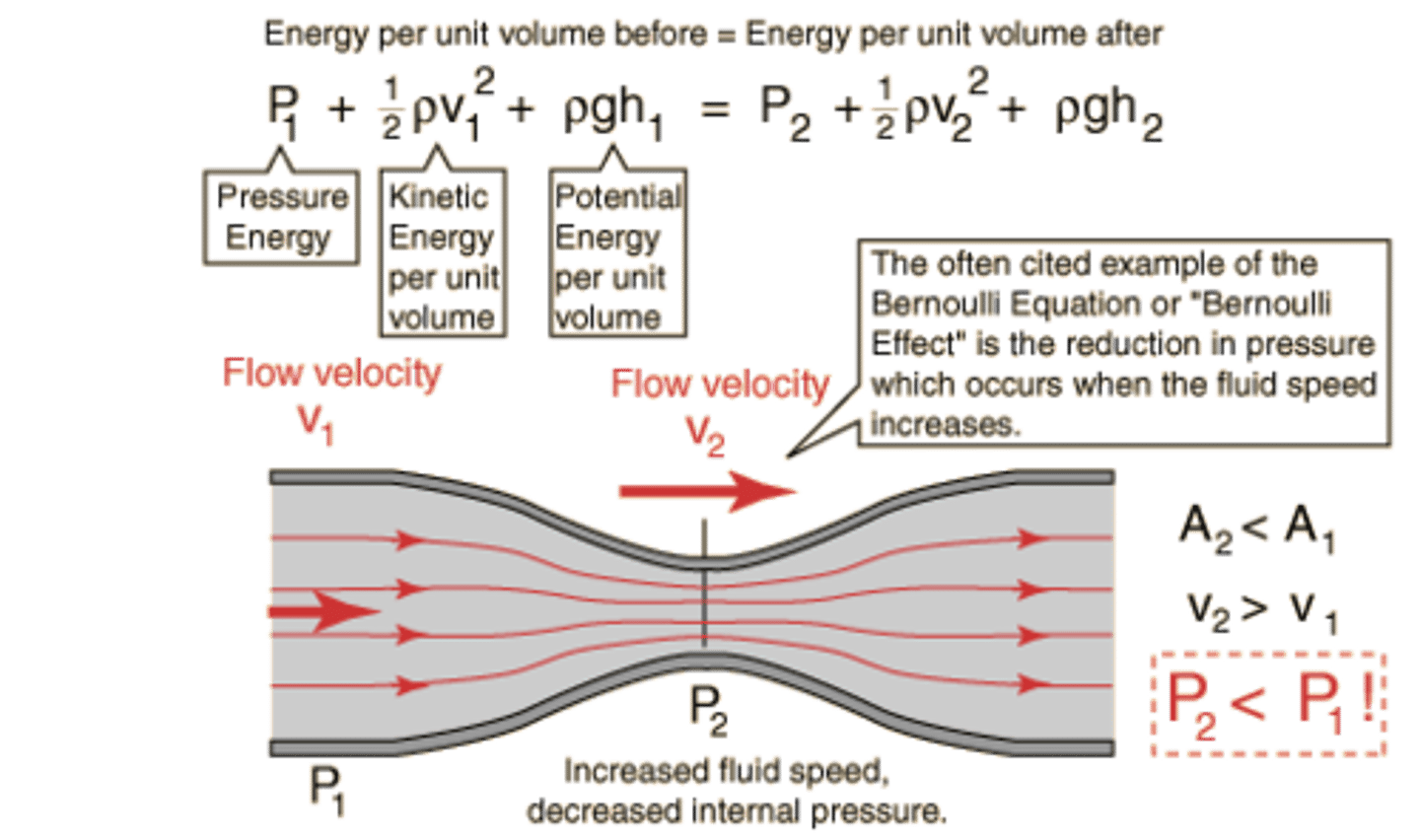
As velocity of object increases, what happens to the force of viscosity?
The force of viscosity increases.
As depth of fluid increases, what happens to the force of viscosity?
The force of viscosity decreases.
One unit used for viscosity is a Poise. Which of the following is 1P equal to?
(A) 1 Pa*s
(B) 10 Pa*s
(C) 0.1 Pa*s
(D) 0.001 Pa*s
(C) 0.1 Pa*s
One Poise is equal to 1/10 of a Pa*s
If the coefficient of viscosity is 4.34 Pa·s, the velocity of a boat along the surface of the liquid is 48.79 m/s, the area of the boat in contact with the fluid is 2.23 m^2, and the depth of the fluid is 5.54 m, what is the Force of viscosity on that object?
(A) 45.63
(B) 63.42
(C) 85.23
(D) 98.46
(C) 85.23
F = η A v/d
F = ((4.34)(2.23)(48.79))/(5.54)
F = approx. 80 N (actual: 85.23)
Need help with MCAT math? Become an MCAT math wizard using Andrew's High-speed Math Mastery Course @ https://mcatselfprep.com/course/andrews-high-speed-math-mastery-course/
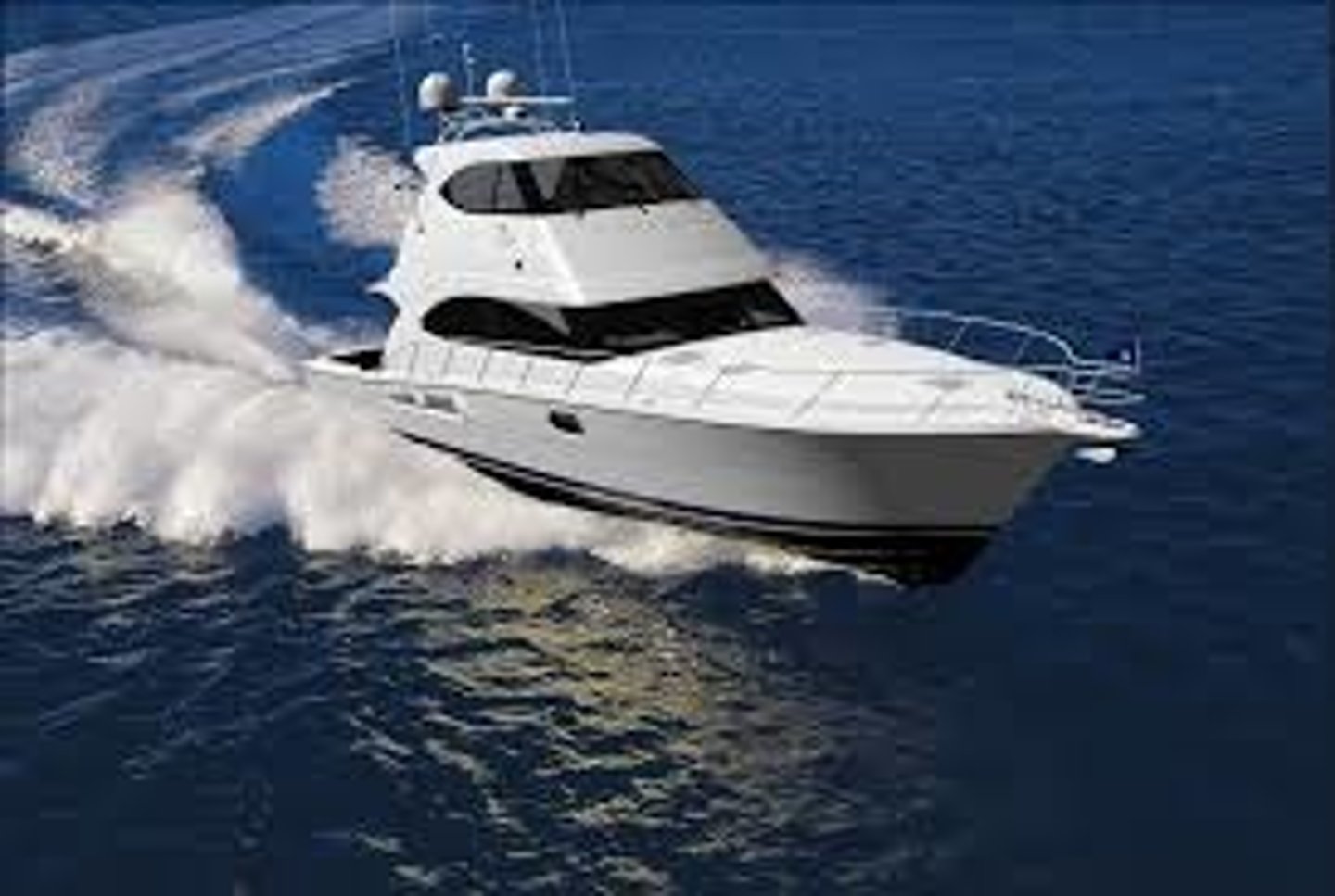
What equation relates flow rate (Q) to velocity and area?
Q = velocity x Area
Struggling to keep your MCAT equations straight? Simply conquer the 100 most important equations using Andrew's 100 Most Essential Equations Mastery Course @ https://mcatselfprep.com/course/andrews-equation-mastery-course/
What happens to flow rate as the length of the tubing increases?
The flow rate decreases.
What is the equation for Poiseuille's Law: Flow Rate in terms of Pressure Gradient?
Q = (∆Pπr^4)/(8ηL)
Q = V/t = Volume/time = Flow Rate (m^3/s)
r = Radius of Tubing (m)
∆P = Pressure Gradient (Pa)
η = Coefficient of Viscosity (Pa·s, or kg/s·m)
L = Length of Tubing (m)
Struggling to keep your MCAT equations straight? Simply conquer the 100 most important equations using Andrew's 100 Most Essential Equations Mastery Course @ https://mcatselfprep.com/course/andrews-equation-mastery-course/
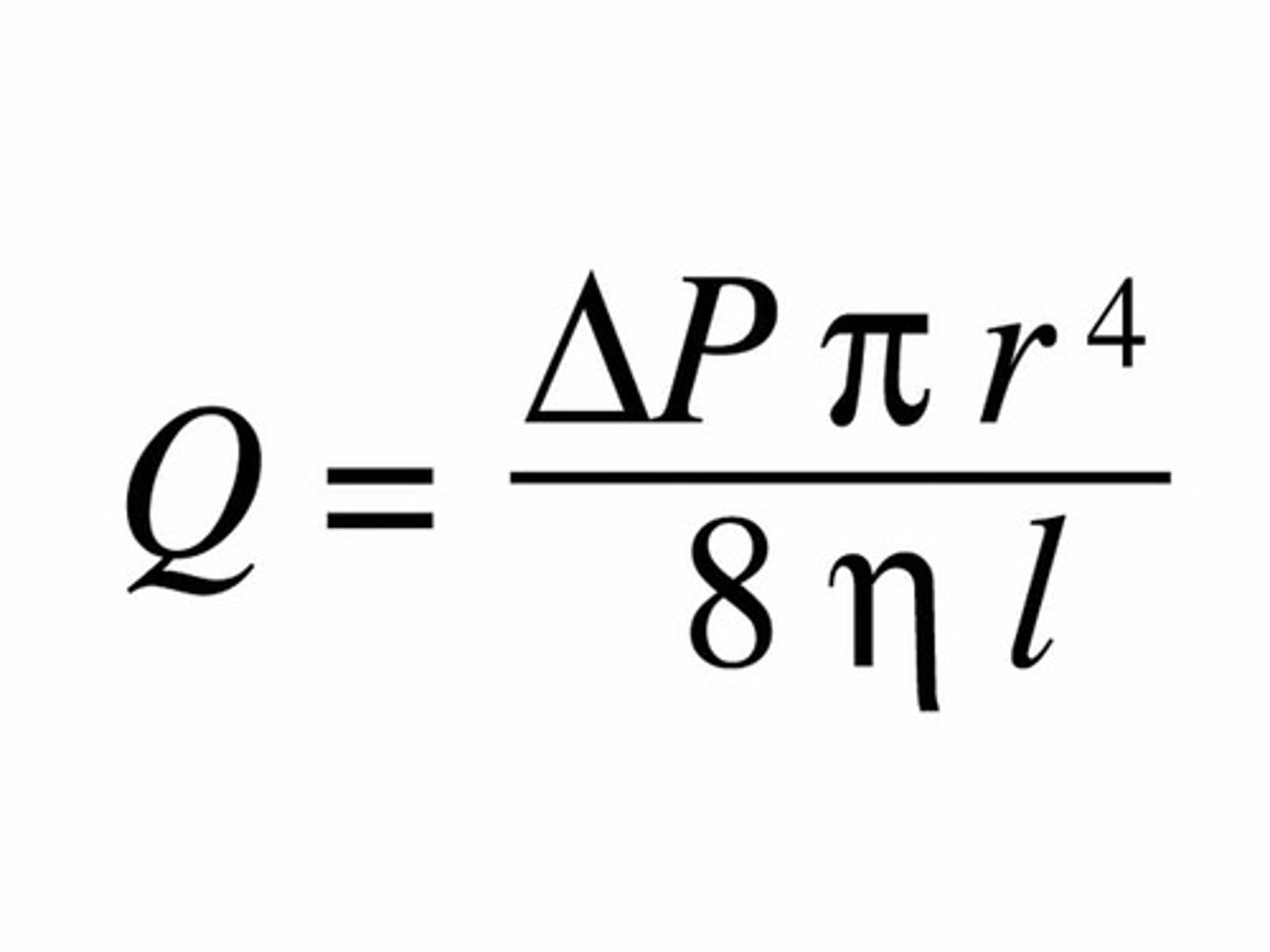
CRB According to Poiseuille's Law, if a blood vessel afflicted by atherosclerosis has its radius decrease to 3/4 of its original size and nothing else changed, how would the flow rate be affected?
(A) The flow rate would be 3/4 of its original rate.
(B) The flow rate would be 4/3 of its original rate.
(C) The flow rate would be 0.3 of its original rate.
(D) The flow rate would be 3.1 times its original rate.
(C) The flow rate would be 0.3 of its original rate.
What happens to flow rate as the pressure gradient increases?
The flow rate increases.
A liquid is flowing through a pipe of length 4 m, with a velocity of 1000 m/s. The radius of the tube is 2 m, and there is a pressure difference of 1,000 Pa from one end of the pipe to the other. What is the coefficient of Viscosity for this fluid (in Pa*s)?
(A) 0.125
(B) 1.47
(C) 18.9
(D) 0.00232
(A) 0.125
Q = velocity x Area
Q = (1000 m/s)(π(2)^2)
Q = 4000π m^3/s
Q = (∆Pπr^4)/(8ηL)
4000π m^3/s = (1,000 Pa)(π)(2^4)/((8)(η)(4))
η = 16,000π/(128,000π) = 0.125 Pa·s
Need help with MCAT math? Become an MCAT math wizard using Andrew's High-speed Math Mastery Course @ https://mcatselfprep.com/course/andrews-high-speed-math-mastery-course/
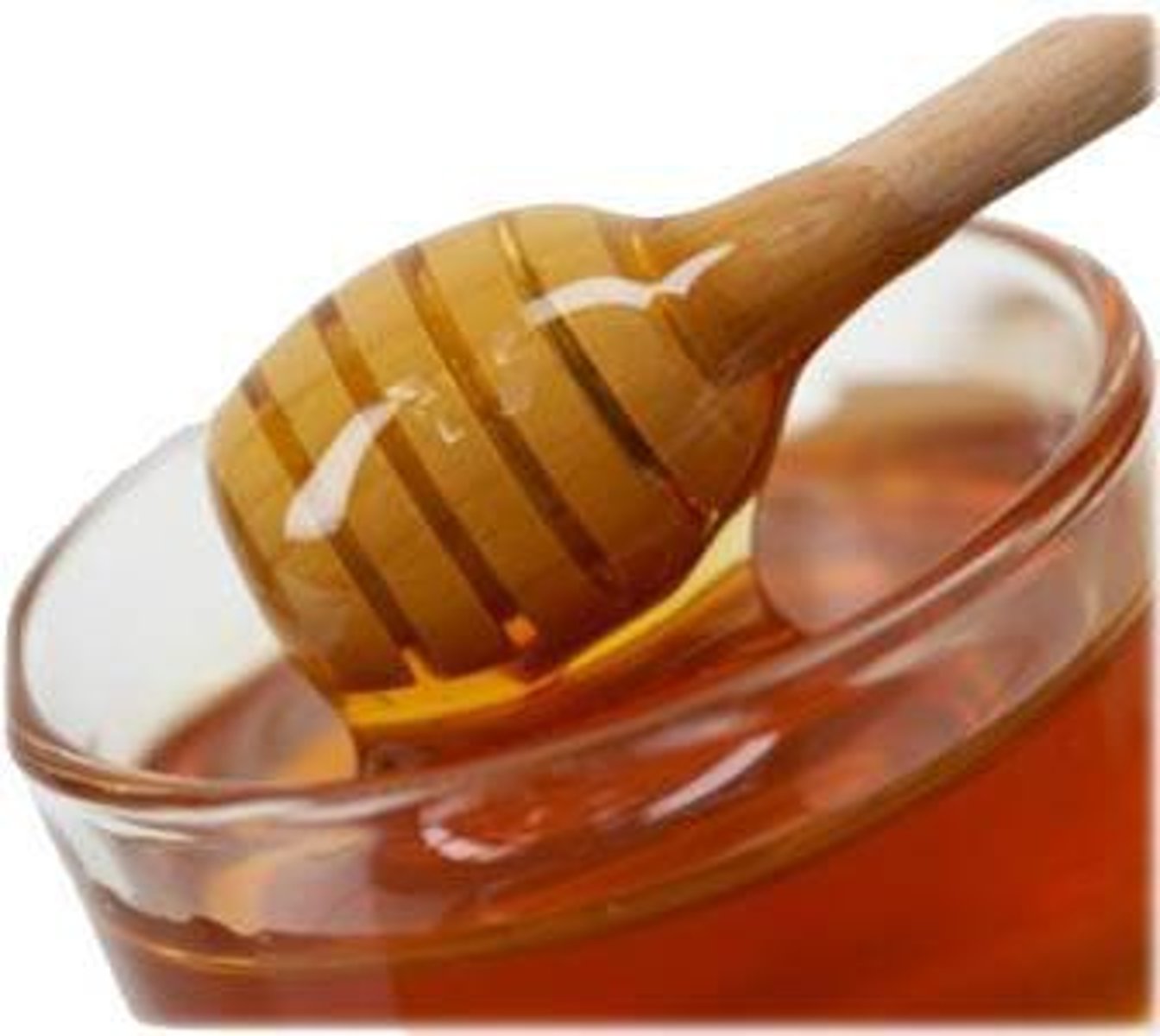
What is the equation for finding Critical Speed in terms of Reynolds Number and Coefficient of Viscosity?
Critical speed = (Rη)/(2ρr)
R = Reynolds Number
η = Coefficient of Viscosity
ρ = Density
r = radius of tube
Struggling to keep your MCAT equations straight? Simply conquer the 100 most important equations using Andrew's 100 Most Essential Equations Mastery Course @ https://mcatselfprep.com/course/andrews-equation-mastery-course/
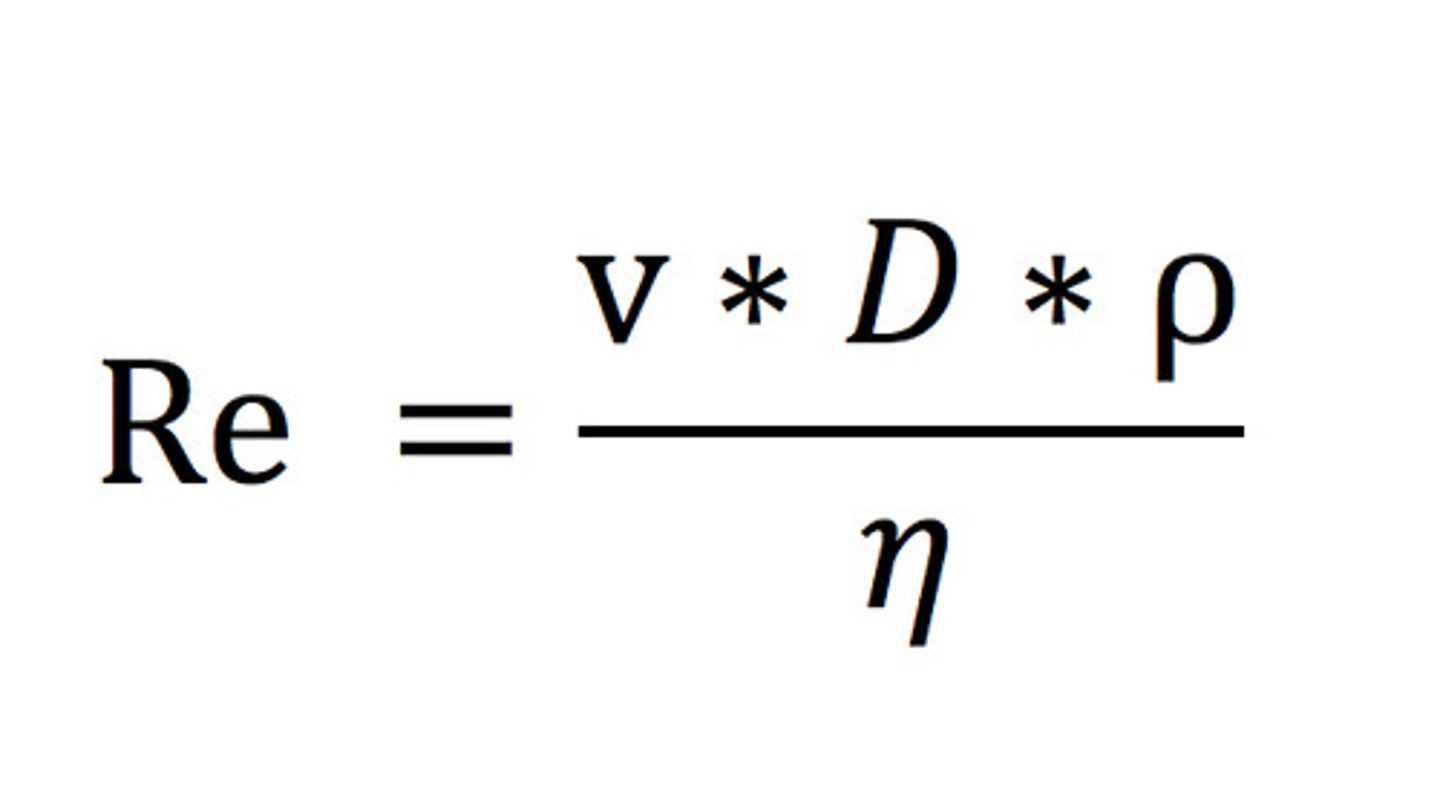
Blood has a Coefficient of viscosity of .004 Pa·s, and a Reynolds number of 2000. If the density of blood is 1060 kg/m^3, and the radius of the aorta is .01 m, what is the critical speed for blood in the aorta?
(A) .08
(B) .22
(C) .38
(D) .59
(C) .38
Critical speed = (Rη)/(2ρr)
Critical Speed = (2000)(.004)/((2)(1060)(.01))
Critical speed = .approx. .4 (actual: .38 m/s)
Need help with MCAT math? Become an MCAT math wizard using Andrew's High-speed Math Mastery Course @ https://mcatselfprep.com/course/andrews-high-speed-math-mastery-course/
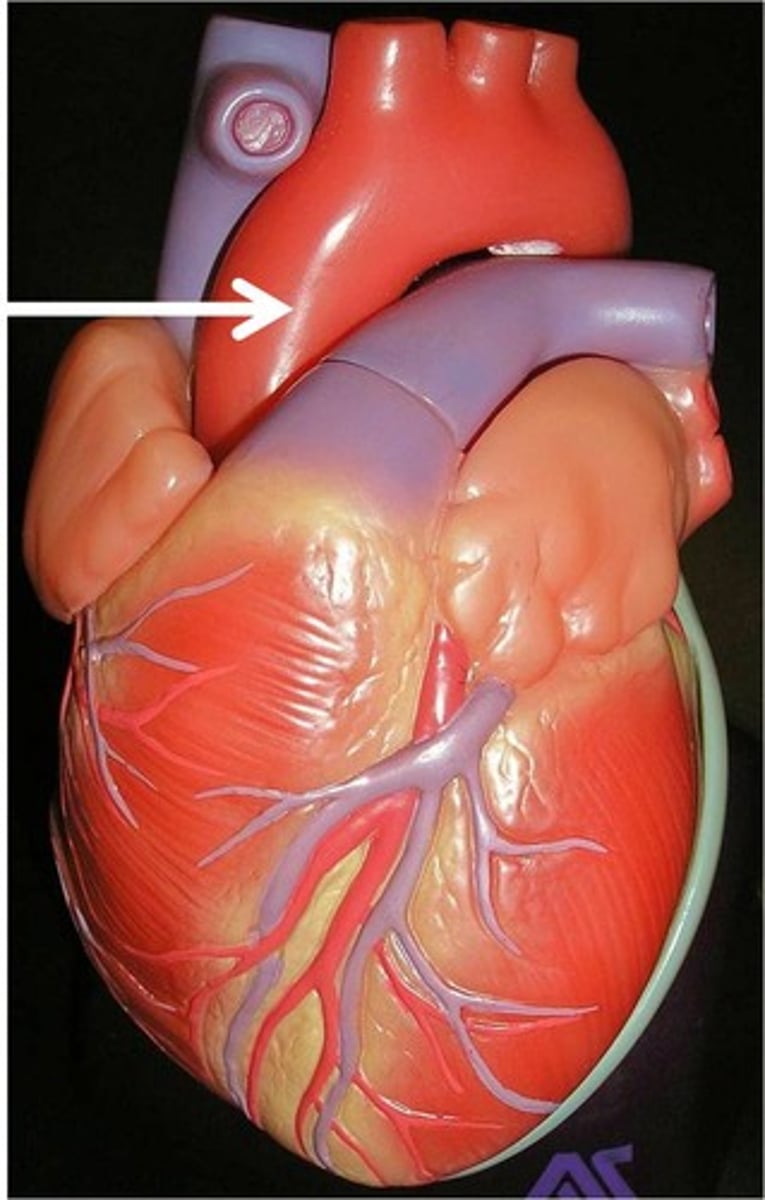
How does the critical speed change as the density of the fluid is increased?
The critical speed decreases.
How does the critical speed change as the radius of the tube is increased?
The critical speed decreases.
CRB True or false? When a fluid exceeds its critical speed, there is no laminar flow at all in the pipe.
False. When a fluid exceeds its critical speed, there is only laminar flow at the very edge of the walls. This area is called the Boundary Layer.
What is the difference between adhesion and cohesion?
Cohesion is the attraction of water molecules to other water molecules. Adhesion is the attraction of water molecules to other surfaces.

What is the venturi effect?
When there is a constriction in a tube, the velocity of the fluid will increase at that point while the pressure will be lower.
This is because the same volume must flow through all parts of a connected pipe at a given time.
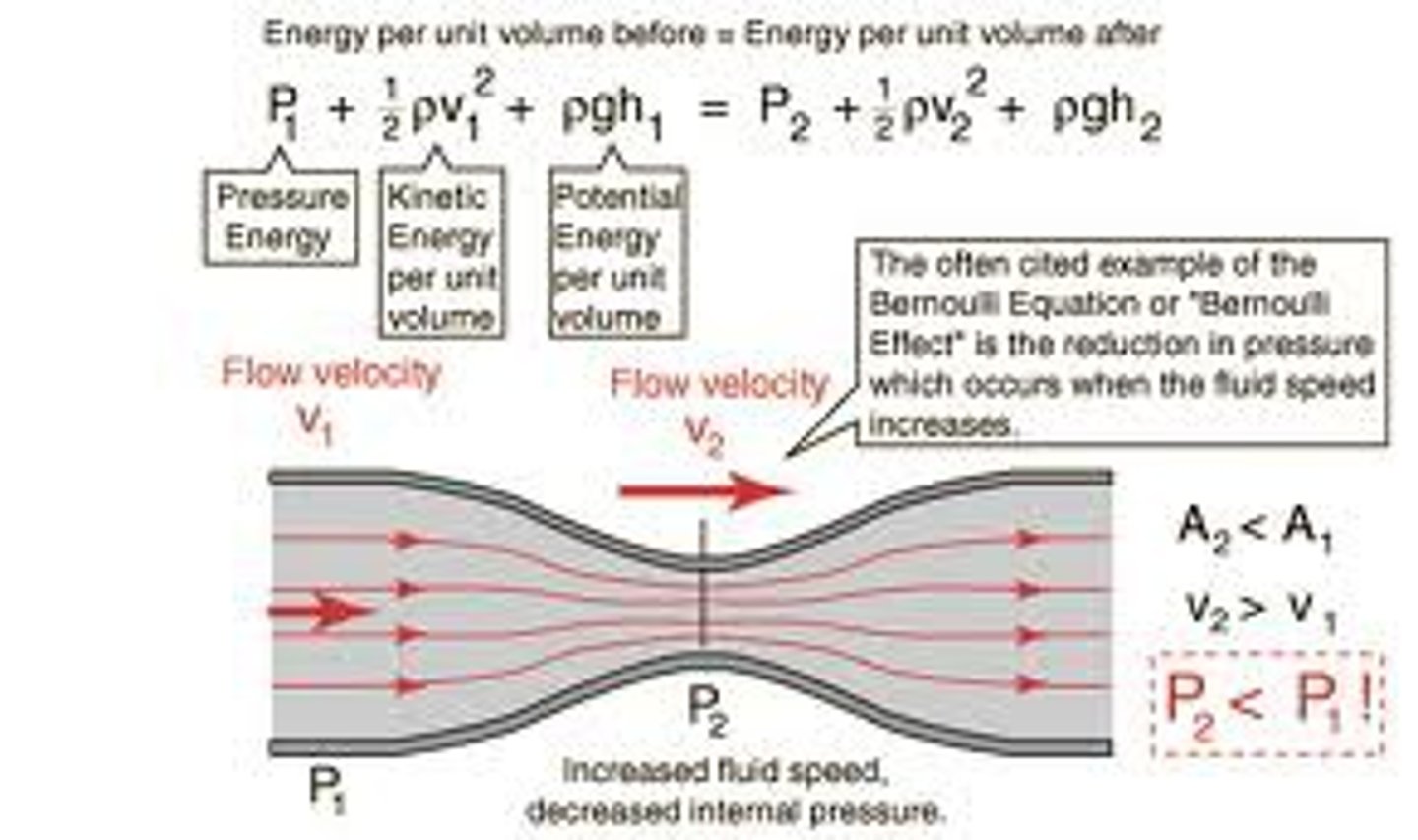
Which of the following correctly describes why an airplane is lifted off of the ground using the Venturi Effect?
(A) The velocity of the air under the wings is greater than the velocity of air above the wings, creating a higher pressure under the wings, giving the airplane lift.
(B) The velocity of the air under the wings is greater than the velocity of air above the wings, creating a lower pressure under the wings, giving the airplane lift.
(C) The velocity of the air under the wings is less than the velocity of air above the wings, creating a higher pressure under the wings, giving the airplane lift.
(D) The velocity of the air under the wings is less than the velocity of air above the wings, creating a lower pressure under the wings, giving the airplane lift.
(C) The velocity of the air under the wings is less than the velocity of air above the wings, creating a higher pressure under the wings, giving the airplane lift.
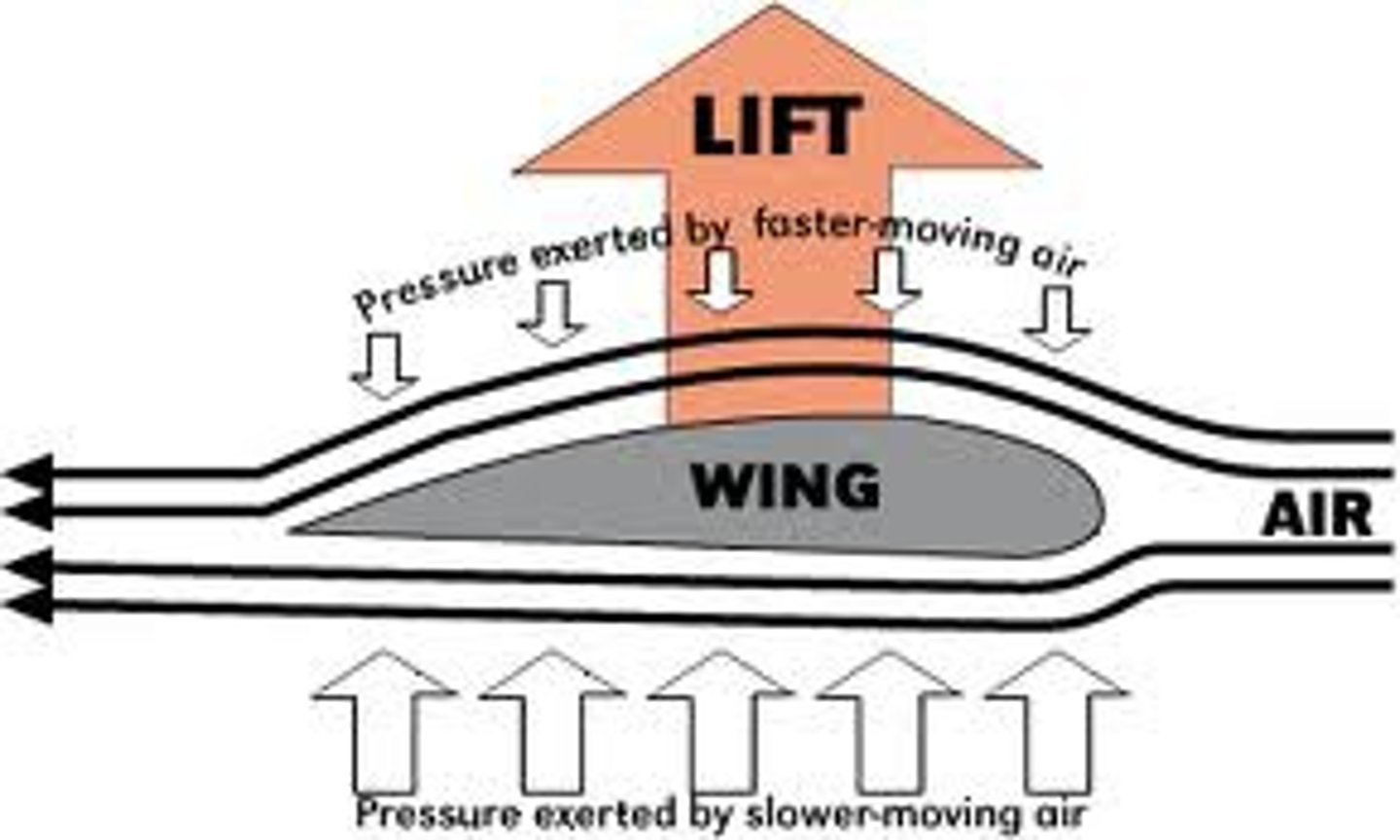
CRB Solids tend to face Stress, which is similar to Pressure for fluids. Which of the following is a key difference?
(A) Stress can take many forms, whereas pressure is only Ambient.
(B) The force of stress doesn't have to be perpendicular to the area it acts over, whereas pressure is always perpendicular to the area and compressing it inwards.
(C) Stress is a force, whereas pressure is a product from the summation of forces.
(D) The only difference is that Stress is for solids and Pressure is for fluids.
(B) The force of stress doesn't have to be perpendicular to the area it acts over, whereas pressure is always perpendicular to the area and compressing it inwards.
CRB Which of the following is NOT one of the three ways that forces can be applied to an object?
(A) Tension (stretching)
(B) Compression (squeezing)
(C) Shear (bending)
(D) Impression (compressing)
(D) Impression (compressing)
The three ways that forces can be applied to an object are:
I. Tension (stretching)
II. Compression (squeezing)
III. Shear (bending)
CRB True or false? Stress refers to the pressure a solid faces, whereas Strain is more like the change in the solid.
True. Stress refers to the pressure a solid faces, whereas Strain is more like the change in the solid.
CRB Hooke has another Law, but instead of being for springs, it is about Stress and Strain. Write out Hooke's Law.

CRB For which of the following types of forces would the modulus of Hooke's Law be called Young's Modulus?
I. Shear Stress
II. Tensile Stress
III. Compressive stress
(A) I only
(B) I and II only
(C) II and III only
(D) I, II and III
(C) II and III only
For Both Tensile and Compressive forces, the modulus in Hooke's Law is Young's Modulus.
For Shear forces, that modulus is simply called the Shear Modulus.
CRB Imagine that there is a degenerative bone condition so that the only thing that changes is the Shear Modulus is cut in half. If you took a femur from a diseased individual and a normal individual with otherwise-identical health and bones, which would bend more, and by how much more?
(A) Healthy bone by a factor of 2
(B) Diseased bone by a factor of 2
(C) Healthy bone by a factor of 4
(D) Diseased bone by a factor of 4
(B) Diseased bone by a factor of 2
The shear modulus relates linearly and inversely with strain/bending, so the one with 1/2 the shear modulus will bend twice as much.